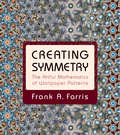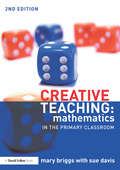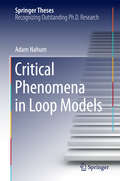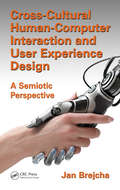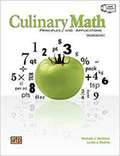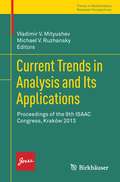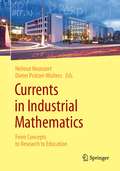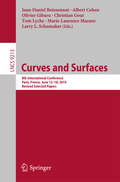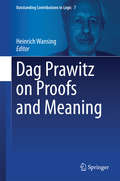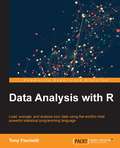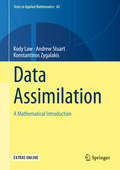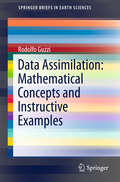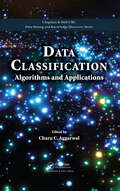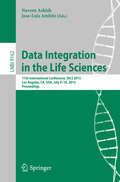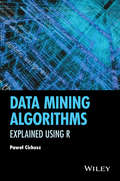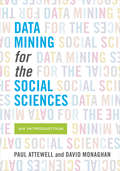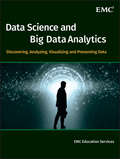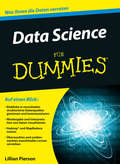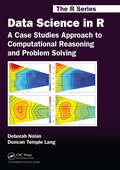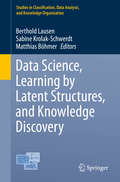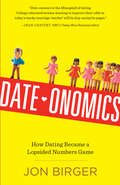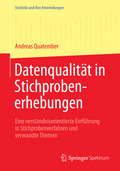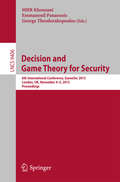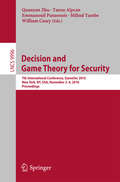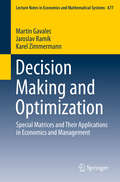- Table View
- List View
Creating Symmetry
by Frank A. FarrisThis lavishly illustrated book provides a hands-on, step-by-step introduction to the intriguing mathematics of symmetry. Instead of breaking up patterns into blocks--a sort of potato-stamp method--Frank Farris offers a completely new waveform approach that enables you to create an endless variety of rosettes, friezes, and wallpaper patterns: dazzling art images where the beauty of nature meets the precision of mathematics.Featuring more than 100 stunning color illustrations and requiring only a modest background in math, Creating Symmetry begins by addressing the enigma of a simple curve, whose curious symmetry seems unexplained by its formula. Farris describes how complex numbers unlock the mystery, and how they lead to the next steps on an engaging path to constructing waveforms. He explains how to devise waveforms for each of the 17 possible wallpaper types, and then guides you through a host of other fascinating topics in symmetry, such as color-reversing patterns, three-color patterns, polyhedral symmetry, and hyperbolic symmetry. Along the way, Farris demonstrates how to marry waveforms with photographic images to construct beautiful symmetry patterns as he gradually familiarizes you with more advanced mathematics, including group theory, functional analysis, and partial differential equations. As you progress through the book, you'll learn how to create breathtaking art images of your own.Fun, accessible, and challenging, Creating Symmetry features numerous examples and exercises throughout, as well as engaging discussions of the history behind the mathematics presented in the book.
Creative Teaching: Mathematics in the Primary Classroom
by Mary Briggs Sue DavisThis stimulating text shows how primary mathematics can be creative, exciting and enjoyable. Offering teachers a dynamic and different perspective, it enables them to see and teach in creative ways that will develop their pupil’s mathematical thinking potential. Creative Teaching: Mathematics in the Primary Classroom encourages students, trainees and practicing teachers to envision and develop a classroom where children can take risks, enjoy and experiment with mathematical thinking, and discover and pursue their interests and talents in an imaginative yet purposeful way. This second edition contains key updates to reflect the changes to the primary curriculum and includes: new sections on: specialist teaching, parental engagement and approaches to homework; creative classroom environments; working walls, displays and outdoor settings; links to assessment, speaking, listening and learning theory; use of media, film, news and stories for creative learning; cross-curricula work. Featuring reflective tasks in every chapter, this book will prove essential and inspiring reading for all trainee and practising teachers looking to develop their creative practice. Aimed at primary and early years trainee teachers, NQTs and experienced teachers, this is a timely publication for teachers and schools seeking to broaden their maths curriculum, making it more creative and appealing to young minds.
Critical Phenomena in Loop Models (Springer Theses)
by Adam NahumWhen close to a continuous phase transition, many physical systems can usefully be mapped to ensembles of fluctuating loops, which might represent for example polymer rings, or line defects in a lattice magnet, or worldlines of quantum particles. 'Loop models' provide a unifying geometric language for problems of this kind. This thesis aims to extend this language in two directions. The first part of the thesis tackles ensembles of loops in three dimensions, and relates them to the statistical properties of line defects in disordered media and to critical phenomena in two-dimensional quantum magnets. The second part concerns two-dimensional loop models that lie outside the standard paradigms: new types of critical point are found, and new results given for the universal properties of polymer collapse transitions in two dimensions. All of these problems are shown to be related to sigma models on complex or real projective space, CP^{{n−1}} or RP^{{n−1}} -- in some cases in a 'replica' limit -- and this thesis is also an in-depth investigation of critical behaviour in these field theories.
Cross-Cultural Human-Computer Interaction and User Experience Design: A Semiotic Perspective
by Jan BrejchaThis book describes patterns of language and culture in human-computer interaction (HCI). Through numerous examples, it shows why these patterns matter and how to exploit them to design a better user experience (UX) with computer systems. It provides scientific information on the theoretical and practical areas of the interaction and communication design for research experts and industry practitioners and covers the latest research in semiotics and cultural studies, bringing a set of tools and methods to benefit the process of designing with the cultural background in mind.
Culinary Math: Principles And Applications
by Michael J. Mcgreal Linda J. PadillaCulinary Math Principles and Applications" demonstrates how and why foodservice workers use math in the professional kitchen. This popular text-workbook helps learners grasp culinary math principles and applications through an engaging and well-illustrated style. Interactive learner resources provide opportunities for reinforcement and further examples of math used in culinary settings. This educational resource can serve as a basis for college culinary math, foodservice math, and hospitality math courses.
Current Trends in Analysis and Its Applications: Proceedings of the 9th ISAAC Congress, Kraków 2013 (Trends in Mathematics)
by Vladimir V. Mityushev Michael V. RuzhanskyThis book is a collection of papers from the 9th International ISAAC Congress held in 2013 in Kraków, Poland. The papers are devoted to recent results in mathematics, focused on analysis and a wide range of its applications. These include up-to-date findings of the following topics: - Differential Equations: Complex and Functional Analytic Methods - Nonlinear PDE - Qualitative Properties of Evolution Models - Differential and Difference Equations - Toeplitz Operators - Wavelet Theory - Topological and Geometrical Methods of Analysis - Queueing Theory and Performance Evaluation of Computer Networks - Clifford and Quaternion Analysis - Fixed Point Theory - M-Frame Constructions - Spaces of Differentiable Functions of Several Real Variables Generalized Functions - Analytic Methods in Complex Geometry - Topological and Geometrical Methods of Analysis - Integral Transforms and Reproducing Kernels - Didactical Approaches to Mathematical Thinking Their wide applications in biomathematics, mechanics, queueing models, scattering, geomechanics etc. are presented in a concise, but comprehensible way, such that further ramifications and future directions can be immediately seen.
Currents in Industrial Mathematics: From Concepts to Research to Education
by Helmut Neunzert Dieter Prätzel-WoltersThis book offers an insider's view of how industrial problems are translated into mathematics and how solving the mathematics leads to convincing industrial solutions as well. In 6 technical chapters, a wide range of industrial problems is modeled, simulated, and optimized; 4 others describe the modeling, computing, optimization, and data analysis concepts shaping the work of the Fraunhofer ITWM. Each technical chapter illustrates how the relevant mathematics has been adapted or extended for the specific application and details the underlying practical problem and resulting software. The final chapter shows how the use of mathematical modeling in the classroom can change the image of this subject, making it exciting and fun.
Curves and Surfaces: 8th International Conference, Paris, France, June 12-18, 2014, Revised Selected Papers (Lecture Notes in Computer Science #9213)
by Albert Cohen Tom Lyche Larry L. Schumaker Jean-Daniel Boissonnat Olivier Gibaru Christian Gout Marie-Laurence MazureThis volume constitutes the thoroughly refereed post-conference proceedings of the 8th International Conference on Curves and Surfaces, held in Paris, France, in June 2014. The conference had the overall theme: "Representation and Approximation of Curves and Surfaces and Applications". The 32 revised full papers presented were carefully reviewed and selected from 39 submissions. The scope of the conference was on following topics: approximation theory, computer-aided geometric design, computer graphics and visualization, computational geometry and topology, geometry processing, image and signal processing, interpolation and smoothing, mesh generation, finite elements and splines, scattered data processing and learning theory, sparse and high-dimensional approximation, subdivision, wavelets and multi-resolution method.
Dag Prawitz on Proofs and Meaning (Outstanding Contributions to Logic #7)
by Heinrich WansingThis volume is dedicated to Prof. Dag Prawitz and his outstanding contributions to philosophical and mathematical logic. Prawitz's eminent contributions to structural proof theory, or general proof theory, as he calls it, and inference-based meaning theories have been extremely influential in the development of modern proof theory and anti-realistic semantics. In particular, Prawitz is the main author on natural deduction in addition to Gerhard Gentzen, who defined natural deduction in his PhD thesis published in 1934. The book opens with an introductory paper that surveys Prawitz's numerous contributions to proof theory and proof-theoretic semantics and puts his work into a somewhat broader perspective, both historically and systematically. Chapters include either in-depth studies of certain aspects of Dag Prawitz's work or address open research problems that are concerned with core issues in structural proof theory and range from philosophical essays to papers of a mathematical nature. Investigations into the necessity of thought and the theory of grounds and computational justifications as well as an examination of Prawitz's conception of the validity of inferences in the light of three "dogmas of proof-theoretic semantics" are included. More formal papers deal with the constructive behaviour of fragments of classical logic and fragments of the modal logic S4 among other topics. In addition, there are chapters about inversion principles, normalization of p roofs, and the notion of proof-theoretic harmony and other areas of a more mathematical persuasion. Dag Prawitz also writes a chapter in which he explains his current views on the epistemic dimension of proofs and addresses the question why some inferences succeed in conferring evidence on their conclusions when applied to premises for which one already possesses evidence.
Data Analysis with R
by Tony FischettiLoad, wrangle, and analyze your data using the world's most powerful statistical programming language About This Book * Load, manipulate and analyze data from different sources * Gain a deeper understanding of fundamentals of applied statistics * A practical guide to performing data analysis in practice Who This Book Is For Whether you are learning data analysis for the first time, or you want to deepen the understanding you already have, this book will prove to an invaluable resource. If you are looking for a book to bring you all the way through the fundamentals to the application of advanced and effective analytics methodologies, and have some prior programming experience and a mathematical background, then this is for you. What You Will Learn * Navigate the R environment * Describe and visualize the behavior of data and relationships between data * Gain a thorough understanding of statistical reasoning and sampling * Employ hypothesis tests to draw inferences from your data * Learn Bayesian methods for estimating parameters * Perform regression to predict continuous variables * Apply powerful classification methods to predict categorical data * Handle missing data gracefully using multiple imputation * Identify and manage problematic data points * Employ parallelization and Rcpp to scale your analyses to larger data * Put best practices into effect to make your job easier and facilitate reproducibility In Detail Frequently the tool of choice for academics, R has spread deep into the private sector and can be found in the production pipelines at some of the most advanced and successful enterprises. The power and domain-specificity of R allows the user to express complex analytics easily, quickly, and succinctly. With over 7,000 user contributed packages, it's easy to find support for the latest and greatest algorithms and techniques. Starting with the basics of R and statistical reasoning, Data Analysis with R dives into advanced predictive analytics, showing how to apply those techniques to real-world data though with real-world examples. Packed with engaging problems and exercises, this book begins with a review of R and its syntax. From there, get to grips with the fundamentals of applied statistics and build on this knowledge to perform sophisticated and powerful analytics. Solve the difficulties relating to performing data analysis in practice and find solutions to working with "messy data", large data, communicating results, and facilitating reproducibility. This book is engineered to be an invaluable resource through many stages of anyone's career as a data analyst. Style and approach Learn data analysis using engaging examples and fun exercises, and with a gentle and friendly but comprehensive "learn-by-doing" approach.
Data Assimilation: A Mathematical Introduction (Texts in Applied Mathematics #62)
by Kody Law Andrew Stuart Konstantinos ZygalakisThis book provides a systematic treatment of the mathematical underpinnings of work in data assimilation, covering both theoretical and computational approaches. Specifically the authors develop a unified mathematical framework in which a Bayesian formulation of the problem provides the bedrock for the derivation, development and analysis of algorithms; the many examples used in the text, together with the algorithms which are introduced and discussed, are all illustrated by the MATLAB software detailed in the book and made freely available online. The book is organized into nine chapters: the first contains a brief introduction to the mathematical tools around which the material is organized; the next four are concerned with discrete time dynamical systems and discrete time data; the last four are concerned with continuous time dynamical systems and continuous time data and are organized analogously to the corresponding discrete time chapters. This book is aimed at mathematical researchers interested in a systematic development of this interdisciplinary field, and at researchers from the geosciences, and a variety of other scientific fields, who use tools from data assimilation to combine data with time-dependent models. The numerous examples and illustrations make understanding of the theoretical underpinnings of data assimilation accessible. Furthermore, the examples, exercises and MATLAB software, make the book suitable for students in applied mathematics, either through a lecture course, or through self-study.
Data Assimilation: Mathematical Concepts and Instructive Examples (SpringerBriefs in Earth Sciences)
by Rodolfo GuzziThis book endeavours to give a concise contribution to understanding the data assimilation and related methodologies. The mathematical concepts and related algorithms are fully presented, especially for those facing this theme for the first time. The first chapter gives a wide overview of the data assimilation steps starting from Gauss' first methods to the most recent as those developed under the Monte Carlo methods. The second chapter treats the representation of the physical system as an ontological basis of the problem. The third chapter deals with the classical Kalman filter, while the fourth chapter deals with the advanced methods based on recursive Bayesian Estimation. A special chapter, the fifth, deals with the possible applications, from the first Lorenz model, passing trough the biology and medicine up to planetary assimilation, mainly on Mars. This book serves both teachers and college students, and other interested parties providing the algorithms and formulas to manage the data assimilation everywhere a dynamic system is present.
Data Classification: Algorithms and Applications (Chapman And Hall/crc Data Mining And Knowledge Discovery Ser. #35)
by Charu C. AggarwalComprehensive Coverage of the Entire Area of ClassificationResearch on the problem of classification tends to be fragmented across such areas as pattern recognition, database, data mining, and machine learning. Addressing the work of these different communities in a unified way, Data Classification: Algorithms and Applications explores the underlyi
Data Integration in the Life Sciences: 11th International Conference, DILS 2015, Los Angeles, CA, USA, July 9-10, 2015, Proceedings (Lecture Notes in Computer Science #9162)
by Naveen Ashish Jose-Luis AmbiteThis book constitutes the proceedings of the 11th International Conference on Data Integration in the Life Sciences, DILS 2015, held in Los Angeles, CA, USA, in July 2015. The 24 papers presented in this volume were carefully reviewed and selected from 40 submissions. They are organized in topical sections named: data integration technologies; ontology and knowledge engineering for data integration; biomedical data standards and coding; medical research applications; and graduate student consortium.
Data Mining Algorithms: Explained Using R
by Pawel CichoszData Mining Algorithms is a practical, technically-oriented guide to data mining algorithms that covers the most important algorithms for building classification, regression, and clustering models, as well as techniques used for attribute selection and transformation, model quality evaluation, and creating model ensembles. The author presents many of the important topics and methodologies widely used in data mining, whilst demonstrating the internal operation and usage of data mining algorithms using examples in R.
Data Mining for the Social Sciences
by Paul Attewell David MonaghanWe live in a world of big data: the amount of information collected on human behavior each day is staggering, and exponentially greater than at any time in the past. Additionally, powerful algorithms are capable of churning through seas of data to uncover patterns. Providing a simple and accessible introduction to data mining, Paul Attewell and David B. Monaghan discuss how data mining substantially differs from conventional statistical modeling familiar to most social scientists. The authors also empower social scientists to tap into these new resources and incorporate data mining methodologies in their analytical toolkits. Data Mining for the Social Sciences demystifies the process by describing the diverse set of techniques available, discussing the strengths and weaknesses of various approaches, and giving practical demonstrations of how to carry out analyses using tools in various statistical software packages.
Data Science and Big Data Analytics: Discovering, Analyzing, Visualizing and Presenting Data
by Emc Education ServicesData Science and Big Data Analytics is about harnessing the power of data for new insights. The book covers the breadth of activities and methods and tools that Data Scientists use. The content focuses on concepts, principles and practical applications that are applicable to any industry and technology environment, and the learning is supported and explained with examples that you can replicate using open-source software.This book will help you:Become a contributor on a data science teamDeploy a structured lifecycle approach to data analytics problemsApply appropriate analytic techniques and tools to analyzing big dataLearn how to tell a compelling story with data to drive business actionPrepare for EMC Proven Professional Data Science Certification
Data Science für Dummies (Für Dummies)
by Lillian PiersonDaten, Daten, Daten? Sie haben schon Kenntnisse in Excel und Statistik, wissen aber noch nicht, wie all die Datensätze helfen sollen, bessere Entscheidungen zu treffen? Von Lillian Pierson bekommen Sie das dafür notwendige Handwerkszeug: Bauen Sie Ihre Kenntnisse in Statistik, Programmierung und Visualisierung aus. Nutzen Sie Python, R, SQL, Excel und KNIME. Zahlreiche Beispiele veranschaulichen die vorgestellten Methoden und Techniken. So können Sie die Erkenntnisse dieses Buches auf Ihre Daten übertragen und aus deren Analyse unmittelbare Schlüsse und Konsequenzen ziehen.
Data Science in R: A Case Studies Approach to Computational Reasoning and Problem Solving (Chapman And Hall/crc The R Ser. #26)
by Deborah Nolan Duncan Temple LangEffectively Access, Transform, Manipulate, Visualize, and Reason about Data and ComputationData Science in R: A Case Studies Approach to Computational Reasoning and Problem Solving illustrates the details involved in solving real computational problems encountered in data analysis. It reveals the dynamic and iterative process by which data analysts
Data Science, Learning by Latent Structures, and Knowledge Discovery (Studies in Classification, Data Analysis, and Knowledge Organization)
by Berthold Lausen Sabine Krolak-Schwerdt Matthias BöhmerThis volume comprises papers dedicated to data science and the extraction of knowledge from many types of data: structural, quantitative, or statistical approaches for the analysis of data; advances in classification, clustering and pattern recognition methods; strategies for modeling complex data and mining large data sets; applications of advanced methods in specific domains of practice. The contributions offer interesting applications to various disciplines such as psychology, biology, medical and health sciences; economics, marketing, banking and finance; engineering; geography and geology; archeology, sociology, educational sciences, linguistics and musicology; library science. The book contains the selected and peer-reviewed papers presented during the European Conference on Data Analysis (ECDA 2013) which was jointly held by the German Classification Society (GfKl) and the French-speaking Classification Society (SFC) in July 2013 at the University of Luxembourg.
Date-onomics: How Dating Became a Lopsided Numbers Game
by Jon BirgerIt’s not that he’s just not that into you—it’s that there aren’t enough of him. And the numbers prove it. Using a combination of demographics, statistics, game theory, and number-crunching, Date-onomics tells what every single, college-educated, heterosexual, looking-for-a-partner woman needs to know: The “man deficit” is real. It’s a fascinating, if sobering read, with two critical takeaways: One, it’s not you. Two, knowledge is power, so here’s what to do about it. The shortage of college-educated men is not just a big-city phenomenon frustrating women in New York and L.A. Among young college grads, there are four eligible women for every three men nationwide. This unequal ratio explains not only why it’s so hard to find a date, but a host of social issues, from the college hookup culture to the reason Salt Lake City is becoming the breast implant capital of America. Then there’s the math that says that a woman’s good looks can keep men from approaching her—particularly if they feel the odds aren’t in their favor. Fortunately, there are also solutions: what college to attend (any with strong sciences or math), where to hang out (in New York, try a fireman’s bar), where to live (Colorado, Seattle, “Man” Jose), and why never to shy away from giving an ultimatum.
Datenqualität in Stichprobenerhebungen: Eine verständnisorientierte Einführung in Stichprobenverfahren und verwandte Themen (Statistik und ihre Anwendungen)
by Andreas QuatemberDas Buch bietet eine verständnis- und anwendungsorientierte Einführung in verschiedene Stichprobendesigns, bestehend aus Auswahlverfahren und Schätzmethodik. Das Methodenverständnis wird unterstützt durch einfach nachvollziehbare und gerade dadurch besonders förderliche Beispiele. Dabei werden auch andere praxisrelevante Aspekte, welche sich auf die Qualität der gezogenen Schlussfolgerungen auswirken, nicht ausgeklammert: Behandelt werden unter anderem die Nonresponse-Thematik sowie die Anwendung von nichtzufälligen Auswahltechniken wie dem Quotenverfahren.
Decision and Game Theory for Security
by Mhr Khouzani Emmanouil Panaousis George TheodorakopoulosThis book constitutes the refereed proceedings of the 6th International Conference on Decision and Game Theory for Security, GameSec 2015, held in London, UK, in November 2015. The 16 revised full papers presented together with 5 short papers were carefully reviewed and selected from 37 submissions. Game and decision theory has emerged as a valuable systematic framework with powerful analytical tools in dealing with the intricacies involved in making sound and sensible security decisions. For instance, game theory provides methodical approaches to account for interdependencies of security decisions, the role of hidden and asymmetric information, the perception of risks and costs in human behaviour, the incentives/limitations of the attackers, and much more. Combined with our classical approach to computer and network security, and drawing from various fields such as economic, social and behavioural sciences, game and decision theory is playing a fundamental role in the development of the pillars of the "science of security".
Decision and Game Theory for Security
by Quanyan Zhu Tansu Alpcan Emmanouil Panaousis Milind Tambe William CaseyThis book constitutes the refereed proceedings of the 6th International Conference on Decision and Game Theory for Security, GameSec 2015, held in London, UK, in November 2015. The 16 revised full papers presented together with 5 short papers were carefully reviewed and selected from 37 submissions. Game and decision theory has emerged as a valuable systematic framework with powerful analytical tools in dealing with the intricacies involved in making sound and sensible security decisions. For instance, game theory provides methodical approaches to account for interdependencies of security decisions, the role of hidden and asymmetric information, the perception of risks and costs in human behaviour, the incentives/limitations of the attackers, and much more. Combined with our classical approach to computer and network security, and drawing from various fields such as economic, social and behavioural sciences, game and decision theory is playing a fundamental role in the development of the pillars of the "science of security".
Decision Making and Optimization
by Martin Gavalec Jaroslav Ramík Karel ZimmermannThe book is a benefit for graduate and postgraduate students in the areas of operations research, decision theory, optimization theory, linear algebra, interval analysis and fuzzy sets. The book will also be useful for the researchers in the respective areas. The first part of the book deals with decision making problems and procedures that have been established to combine opinions about alternatives related to different points of view. Procedures based on pairwise comparisons are thoroughly investigated. In the second part we investigate optimization problems where objective functions and constraints are characterized by extremal operators such as maximum, minimum or various triangular norms (t-norms). Matrices in max-min algebra are useful in applications such as automata theory, design of switching circuits, logic of binary relations, medical diagnosis, Markov chains, social choice, models of organizations, information systems, political systems and clustering. The input data in real problems are usually not exact and can be characterized by interval values.
